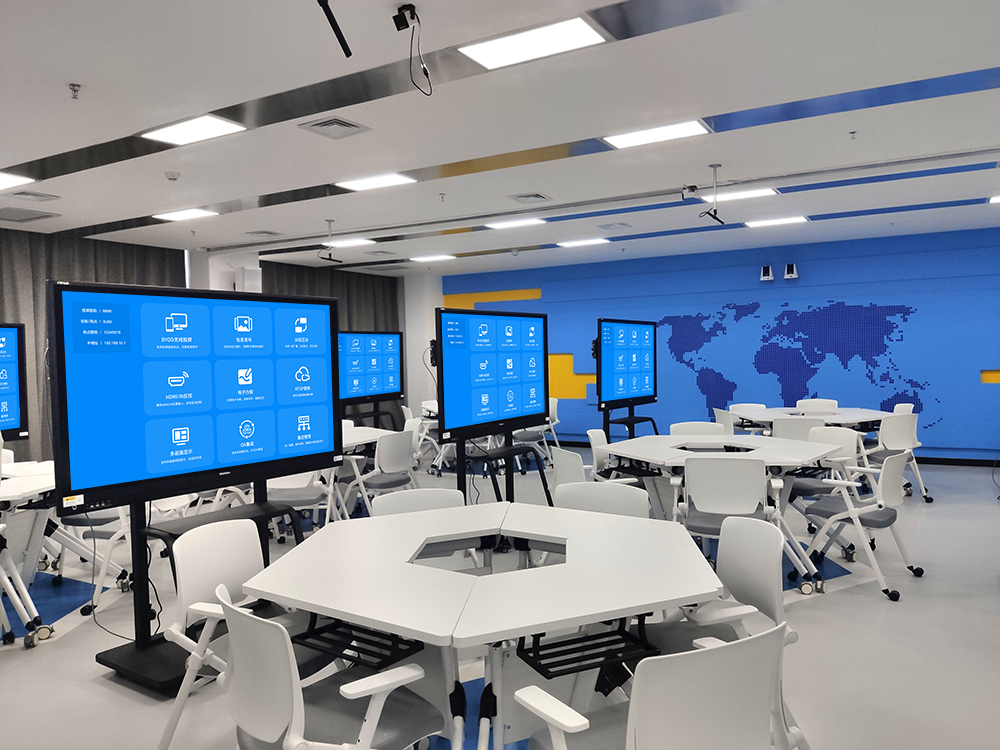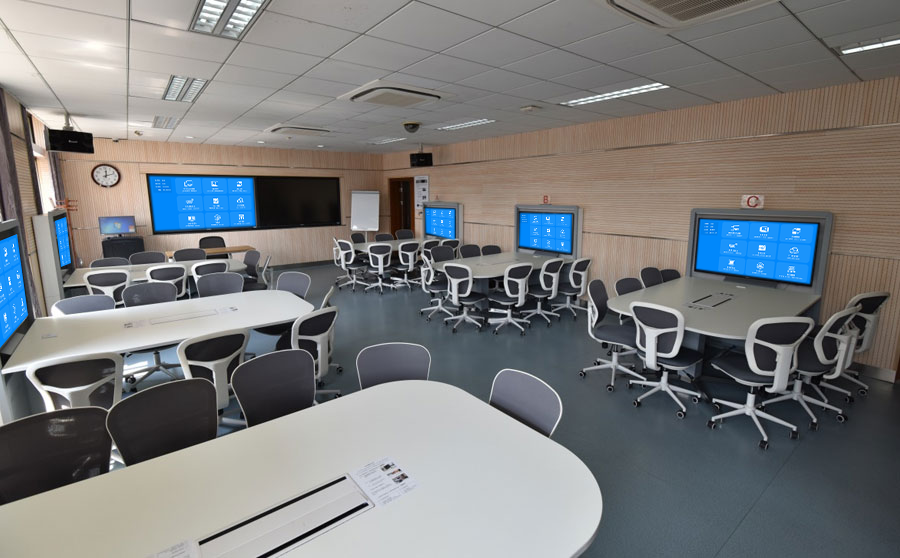Use This for Multi-Screen Interaction: More Efficient Device Collaboration
Want to break free from the limitations of computers, phones, tablets, and large screens “operating independently“? This screen mirroring device easily sets up multi-screen interactive scenarios! It supports real-time content flow, two-way operation, and synchronized annotations across multiple devices, covering office collaboration, family sharing, and training interactions. With no complex setup, it allows multiple screens to move from “independent operation” to “collaborative effort,” enhancing both efficiency and experience.
1-Minute to Set Up an Interactive Environment, Zero Technical Threshold
The operation is so simple that people of all ages can master it:
- Quick Device Connection and Networking: Plug the screen mirroring receiver into the main screen (conference screen/TV/projector). If needed, plug additional receivers into secondary screens. After powering on, they automatically assign identifiers (e.g., “Main Screen – Proposal Display,” “Secondary Screen – Data Supplement”). Plug the transmitter into your computer. Phones and tablets connect to the same Wi-Fi (if there’s no network, you can connect to the mirroring device’s hotspot). Multi-device interconnection is completed in 10 seconds, with no drivers or software installation required.
- One-Tap to Start Collaboration: Click the screen mirroring device’s “Interactive Mode” on your computer. Scan the QR code with your phone/tablet to confirm. Multiple screens will instantly synchronize. Content can flow freely between devices; for example, a proposal document from your computer can be pushed to your phone for annotation, and on-site photos from your phone can be transferred to the large screen for display. There are no technical barriers throughout the entire process, and new users can learn by watching once.
Core Advantages: More In-Depth Multi-Screen Interaction
Content Flows Across Screens, Breaking Device Barriers
- Instant Material Transfer with No Lag: PPT proposals from your computer, meeting minutes taken with your phone, and mind maps drawn on your tablet can be instantly transferred to other screens with the mirroring device’s “cross-device pushing” function. No need for USB drives or WeChat transfers, boosting file transfer efficiency by 70% and avoiding the awkwardness of “waiting forever to transfer files.”
- Complementary Multi-Screen Display: The main screen displays core content (e.g., meeting proposals, teaching lesson plans), the secondary screen shows auxiliary materials (e.g., data charts, experimental videos), and phones/tablets provide real-time details (e.g., temporary client requests, student questions). Multi-screen cooperation makes information transfer more comprehensive, avoids “single-screen information overload,” and leads to a more thorough understanding by the audience.
- Collaborative Editing: Initiate document editing on your computer. A tablet can continue annotating key data, and a phone can add text explanations. All modifications are synchronized to all screens in real-time, eliminating repetitive file transfers for multi-person collaboration and ensuring a smoother flow of ideas, avoiding “version confusion.”
Two-Way Interactive Operation, More Flexible Experience
- Unrestricted Cross-Device Control: After casting content from your computer to the main screen, you can use your phone to remotely flip pages, pause, and annotate, even when walking to a corner of the conference room. When a tablet displays a design draft, the computer can simultaneously retrieve reference materials and push them to the secondary screen. Operations are not limited by device location, making interaction more free.
- Real-time Collaborative Annotation: During office discussions, multiple people can annotate proposal details on different devices—Colleague A highlights data on a computer, Colleague B suggests modifications on a phone. Annotations are synchronized to all screens in real-time, eliminating the need to huddle around a single device. Remote collaboration feels like “face-to-face” interaction.
- Dynamic Data Synchronization: In training and teaching, students answer questions on their phones and submit assignments on tablets. Results are automatically summarized by the mirroring device, generating charts that are cast to the main screen. The instructor can intuitively grasp learning progress and adjust the teaching pace in time, avoiding the inefficient mode of “one-way output,” boosting interaction rates by 60%.
Full Device and Scenario Compatibility, Comprehensive Adaptation
- It covers all operating systems: Windows, macOS, iOS, and Android. The compatibility rate for computers, phones, and tablets from brands like Lenovo, HP, Apple, and Huawei exceeds 98%. Even old devices can interact smoothly, so you don’t have to give up collaboration due to “model incompatibility.”
- It supports three interactive modes: mirroring (full-screen synchronization, suitable for demonstrating operation steps), targeted pushing (transmitting only specified content, suitable for privacy protection), and split-screen display (presenting multiple contents simultaneously, suitable for comparative analysis). Switch as needed to meet different scenario demands.

Applicable to All Scenarios: Multi-Screen Empowers Various Fields
Office Collaboration: Doubled Efficiency
- During proposal discussions, the computer casts the framework to the main screen. Colleague A annotates modification suggestions on a tablet (e.g., “budget needs optimization here”), and Colleague B takes photos of competitor products to supplement on the secondary screen. All content is synchronized in real-time. Discussions don’t require repeatedly switching devices. You can complete 3 rounds of proposal optimization in 1 hour, boosting efficiency by 50% compared to traditional meetings.
- In remote meetings, the local team uses a “main screen + secondary screen” to display proposal details. Remote colleagues join the interaction with their phones/computers, annotating and asking questions in real-time. Cross-regional communication feels like “being in the same room,” avoiding the awkwardness of “remote meetings feeling like lectures” and making decision-making more efficient.
Family Sharing: Warmer Atmosphere
- During family gatherings, take turns casting travel photos and children’s growth videos from phones to the TV (main screen). A tablet can simultaneously play background music, and a computer can retrieve old photos and push them to the secondary screen. Multi-screen cooperation creates a “family memory exhibition.” Grandparents can remotely control the photo switching pace with their phones. No need to crowd around a small screen, making sharing more enjoyable.
- When children attend online classes, the computer casts the course to the TV (large screen for eye protection). A tablet is used for note-taking, and a phone is used for looking up learning materials. Multi-screen division of labor is clear. Parents can remotely control course pauses with their phones to answer questions promptly, boosting learning focus and avoiding the problem of “children hurting their eyes by looking at small screens.”
Training: More In-Depth Interaction
- The instructor casts lesson plans from the computer to the main screen. A tablet provides real-time annotations of key points (e.g., “remember this formula”), and a phone pushes in-class questions to trainee devices. Trainee answer results are automatically summarized into charts and cast to the secondary screen. The instructor provides targeted explanations for incorrect questions, boosting interaction rates by 60% compared to traditional training.
- In practical training, the main screen displays operation steps, and the secondary screen shows close-up details (e.g., machine part installation). Trainees take photos of their operations with their phones and upload them to the secondary screen. The instructor annotates and guides on the main screen, eliminating the need to check each device individually, boosting training efficiency by 40% and accelerating trainee mastery.
Practical Details: More Peace of Mind for Daily Use
- Stable Transmission and Anti-interference: Dual-band (2.4GHz+5.8GHz) transmission technology ensures that when multiple devices interact simultaneously, latency is less than 15ms, and the disconnection rate is below 0.1%. Critical scenarios like meetings and training won’t experience interruptions, avoiding the awkwardness of “disconnection halfway through interaction.”
- Privacy and Security Guaranteed: Supports “interactive permission control,” allowing only authorized devices to join the collaboration group. Mirrored content is encrypted during transmission, protecting office data and family photos from leakage, ensuring peace of mind.
- Portable and Easy to Store: The screen mirroring device is palm-sized, weighing less than 40g. It can be slipped into a laptop bag for business trips or travel. Multi-screen interactive scenarios can be set up in clients’ offices or outdoor training venues at any time, plug-and-play, without carrying bulky equipment.
Whether for office collaboration, family sharing, or training, using this screen mirroring device to achieve multi-screen interaction can break down device barriers, allowing multiple screens to move from “independent use” to “collaborative effort,” making every interaction simple, smooth, and efficient, truly unleashing the value of multi-device collaboration.